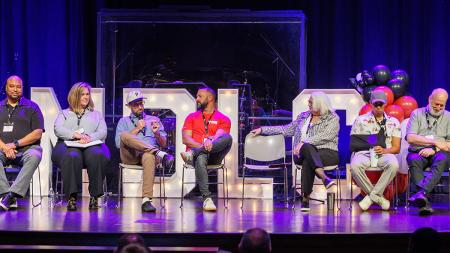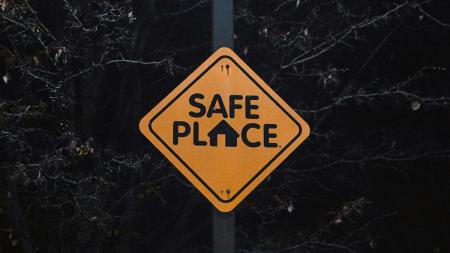Ending Ableism at Church

Church leaders, disability advocates, and people simply interested in learning how to make churches more welcoming and inviting to people with disabilities gathered recently for an online training event on the theme “Let's End #AbleismAtChurch.”
About 170 participants from around North America met for the online conference Aug. 11-12 to learn from four plenary speakers and 11 panelists on topics related to accessibility, disability, ableism, and belonging.
Organizers of the training modeled accessibility in several ways. Lindsay Wieland Capel, director of Disability Concerns for the Christian Reformed Church in North America, noted, “We had ASL, Korean, and Spanish interpreters, asked during registration what accommodations were needed, provided descriptions of ourselves for people who are blind, identified our names when we spoke, used live captioning, and did not use the chat feature so that it didn’t disrupt people using screen readers.”
The first day of the training focused on the basics of ableism. Keynote speakers Jasmine Duckworth and Chantal Huinink described ableism as discrimination in favor of nondisabled people. For many people, when they think of accessible spaces, they think of ramps or elevators, ASL interpretation, or hearing loops. Huinink explained that those are a good start, but ableism can involve attitudes as well as communication and physical access.
Some examples of attitudinal ableism include assumptions that people with disabilities need to be served but aren’t able to serve, or that the greatest desire of people with disabilities is to be rid of their disabilities. Huinink, who lives with cerebral palsy and uses a wheelchair, shared that strangers often offer to pray for her, which is always awkward. If she agrees, they usually pray for her healing, without asking if that's what she actually wants prayer for. She explained that it’s better to only offer prayer to someone if you know them, and to ask them what they would like prayer for. Huinink shared that many people who have lived for years with a disability have become accustomed to it and consider it part of their identity, which makes prayers for healing unhelpful.
Cara Milne is the chair of Disability Concerns Canada and served as one of the hosts of the event. She appreciated that people were willing to share their individual stories. “I keep thinking about the gentleman who has had random strangers come up to him, grab dirt, and spit into it – and smear it over his eyes. They believed they would cure his blindness.” She said she was troubled by other stories of people being disrespected, judged, or not able to enter buildings. “Ableism within our church communities is everywhere – we all have so much to learn.”
In terms of language, Duckworth and Huinink agreed that “disability” or “disabled” are perfectly acceptable terms. Words like “differently abled” and related terms suggest that disabilities themselves – not just the language used to describe them – are bad or unacceptable. Person-first language such as “a person with a disability” is generally recommended in communicating about disabilities, Duckworth noted, but she added that some people prefer to embrace it as part of their identity and prefer to describe themselves as “disabled.”
Gloria McCanna, a minister in the Reformed Church in America (RCA), said she appreciated the efforts to include everyone during the training, the speakers’ introducing themselves with a personal description, and the encouragement to think more deeply about accessibility, inclusion, and ableism. “This training was an excellent place for me to start unpacking all of this. . . . I was challenged to think about my own theology of disability and healing.”
The second day’s sessions aimed to give participants ideas and resources to work on toward ending ableism in churches. In addition to noting the more-common physical-access accommodations and communication tools, keynote speakers Melinda Baber and Lynn Swedberg encouraged churches to consider invisible disabilities, such as sensitivity to bright lights, sudden noises, or overstimulation. Suggestions for accommodations included providing a “safe space” in the sanctuary or classroom with a sheer curtain and some calming sensory items; access to a weighted blanket; and kits available to members to suit their needs, such as a visor for bright-light aversion, fidgets and soothing toys, or noise-canceling earphones for noise aversion.
After each day’s keynote speeches, participants could join in on breakout discussions to share what they had learned and to formulate questions for the panel. Then each day’s panel discussion included time for sharing experiences and answering some of the contributed questions.
“Given the gravity and relevance of the topic, this was the most compelling training event I’ve been part of in my 13 years in this role,” shared Terry DeYoung, coordinator for Disability Concerns for the RCA. He added, “I could not have been more pleased with our four keynote speakers and 11 panelists. They all spoke with such heart and relevance out of their own lived experiences.”
Ableism is the theme for Disability Concerns this year, with opportunities to learn more through Disability Awareness Sunday (Oct. 9 in the RCA; Oct. 16 in the CRC) and other events and resources. Wieland Capel invited interested people to host a book club on Disability Concerns’ book of the year, My Body Is Not a Prayer Request by Amy Kenny. “A recording of the conference will soon be available at bit.ly/ableismatchurch for anyone who missed it,” said Wieland Capel. “We encourage church staff teams to watch the training together.”
For more resources on helping your church to end ableism, visit crcna.org/disability or rca.org/disability.


